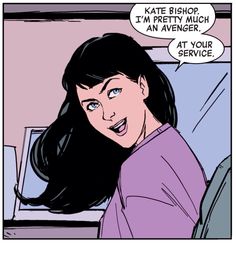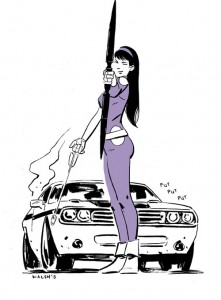The Importance of Kate Bishop
By Tyler Edwards

One of the events that led Kate to become a member of the Young Avengers was her being attacked in Central Park. While it is never stated outright that the assault was sexual, during an interview Jessica Jones tells Kate that she understands what she is going through, because something similar happened to her (a reference to Jones’ origin story in Alias). To help herself through this intense personal trauma, Kate takes up martial arts, archery, and swordplay. While this period of Kate’s backstory is never discussed in detail, it contributes to the complexity and strength Kate shows throughout both series, while also tackling the issue of violence against women with unusual sensitivity.
One of the best things about Kate’s identity at the beginning of Young Avengers is her struggle to find a codename. Her teammates suggest names like ‘Weapon Woman’ and ‘Hawkingbird’, only to have Captain America gift her Clint Barton’s old bow and arrows, with a note addressing her as Hawkeye. What is so significant about this is that she is not referred to as ‘Lady Hawkeye’, ‘Hawkette’, or ‘Miss Hawkeye’—she’s just Hawkeye. She takes on the mantle without it having to be adjusted for her gender. She’s not a spinoff or a sidekick, she’s the real deal, as is borne out by her eventual leadership of the team.

Kate is also distanced from the tired tropes of comic-book misogyny by her sexual agency. In the first series of Young Avengers her costume is fairly provocative: it’s tight, purple, and shows off her midriff. While it does seem functional, it’s clearly designed for the male gaze. However, though she is ostensibly a ‘hot girl in a sexy outfit’, she retains her own personhood and is not defined her relationships or by the stereotypes so often attached to women in comics. During the second run of Young Avengers, she’s shown to be in a casual relationship with Kree playboy, and eventual team member, Noh-Varr. Throughout this relationship, Kate turns the rhetoric of male chauvinism on its head, at one point telling Noh-Varr to “be pretty and silent.” Nor-Varr is frequently drawn shirtless, showing off his traditionally ‘super-heroic’ musculature. This objectification of a male character through the female gaze is a nice reversal of the hypersexualzation usually reserved for women in comics. The same can be said for her time with Clint, as well. Kate is never sexualized, typically shown in jeans and a jacket, or her surprisingly non-formfitting hero attire. Conversely we see Clint shirtless plenty of times, and even a bit more on other occasions. It would be easy to argue that he, not Kate, is the one being objectified in the series.
Kate Bishop is everything one might want a strong female character to be—not just in comics, but in any medium. Her femininity, or sometimes lack thereof, is never a point of weakness or shame. She is a warrior because she chose to be a warrior, not because it was forced on her, or because she was randomly drank a radioactive soft drink. Even without powers she has proven herself as the leader of a team of superheroes, and has even shown a seasoned member of the Avengers a thing or two about archery, quick wit, and friendship.
